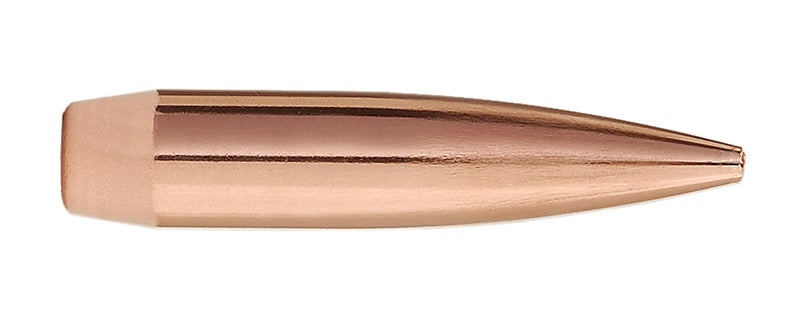Hollow-Point Rifle Bullets are More Accurate. But Why?
Russ Chastain 08.21.18

We live in an imperfect world, in which no bullet is perfect for any given job. But the best bullet for match-grade rifle accuracy has proven to be a boattail hollowpoint… and a recent article at NRA’s Shooting Sports USA website takes a close look at why that is. (Spoiler alert: it’s because hollowpoint (HP) bullets can be built with more precision than full metal jacket (FMJ) bullets.)
After a short history lesson in rifle match ammo and the happenstance of hollowpoint boattail bullets emerging as the clear leader in precision shooting, Michael Bussard begins to delve into the reasons why a precisely-made hollowpoint is better than other types of bullet for accurate rifle shooting.
It begins with a look at ballistics:
From the standpoint of exterior ballistics, an efficient match rifle bullet would have a high length-to-diameter ration; a sharp, drag-reducing point; and a tapered base (boattail). Such a bullet would offer high retained velocity, flat trajectory and minimum wind drift.
From the standpoint of terminal ballistics, the ideal match rifle bullet would offer a center of gravity displaced toward the base, a jacket with no sidewall variations and a core with no weight variation. Such a bullet would offer consistent, reliable, sub-minute-of-angle (MOA) accuracy from lot to lot.
But why a hollow point? Well, there are a number of reasons, and they start with the jacket. An accurate bullet must have a good square base, very few variations in jacket thickness, and even distribution of weight in terms of the lead core inside the jacket.
A rifle bullet’s copper jacket is formed in such a way that variations in thickness — which inevitably cause accuracy deviations — are unavoidable. But the process of making a hollowpoint bullet jacket allows manufacturers to minimize that, while at the same time constructing the bullet in the most symmetrical way possible to date.
They first form the jacket with a nice square base (heel) and an open front end, through which the lead core is inserted. The jacket is then formed from the front using the bullet’s heel as a base, which makes it easy to keep said heel nice and square… and because the front of the jacket is formed against air (the hollow point) as it’s being given its tapering profile, there’s less opportunity for thickness variations to be introduced into the copper jacket.

This is pretty much the opposite of how a FMJ bullet is made; their cores are shoved in from the rear, which causes variation in weight & jacket thickness, and makes it more difficult to form a good square heel.
But, you say, what about that pointy front on an FMJ rifle bullet? Won’t it slice through the air better than the small flat front end (meplat) of an HP? Well, he says, not so much.
Many shooters feel the sharp point on an FMJ bullet will slice through the air better than a hollow point bullet which has a small flat (or meplat) across the tip. While the sharp point of the FMJ bullet is slightly more efficient than the hollow point design, the difference is minimal. This is because tip drag on a pointed bullet accounts for less than five percent of total drag. In real terms therefore, the sharp tip of the FMJ is barely a percent or two more efficient than the hollow point.
Oh, and please don’t use hollowpoint match bullets for hunting. That hollow tip isn’t designed to expand; it’s all about weight distribution and ballistics.
Hollow-point match rifle bullets have a very small opening in the nose. This minimal opening is designed to maintain a minimal meplat. It is not designed for expansion. In fact, most hollow-point match rifle bullets will not expand on impact unless the target is at extremely close range and even then, expansion may be erratic. (For those reasons, match bullets should never be used for hunting.)
And an entry at the Sierra Bullets website further explains that a bullet isn’t suited for hunting just because it has a hollow point:
Hollow Point is a bullet shape used for the MatchKing bullets as well as a number of Varminter, GameKing, and Pro-Hunter bullets for hunting. The Hollow Point shape has an opening in the nose, which depending on the use of the bullet, may be designed for complete fragmentation, controlled expansion, or no expansion at all (MatchKing). With the wide range of Hollow Point bullet performance capabilities, proper bullet selection for a particular use is crucial to ensure the desired performance in the field.
And what about that boattail, i.e. the tapered portion at the heel of the bullet? Like so many other things, its size and length varies widely.
The streamlined, tapered base of the boattail bullet significantly reduces base drag that translates directly into higher retained velocity, flatter trajectory and less wind drift. These are vitally important advantages for competitors at all ranges. However, one size does not fit all and a tapered base eats up bearing surface, so boattails come in different lengths and taper angles tailoring each to bullet caliber, length, weight and average muzzle velocity.
He wraps up by noting the lack of a cannelure on match bullets. The cannelure is the groove around the perimeter of a bullet which is designed to engage with the case mouth when the case neck is crimped. But the act of forming a cannelure distorts bullets to some degree, which is bad for match-grade accuracy… and nobody crimps match ammo anyhow.
Pretty cool stuff, if you ask me. It’s nice to learn about things we so often take for granted.